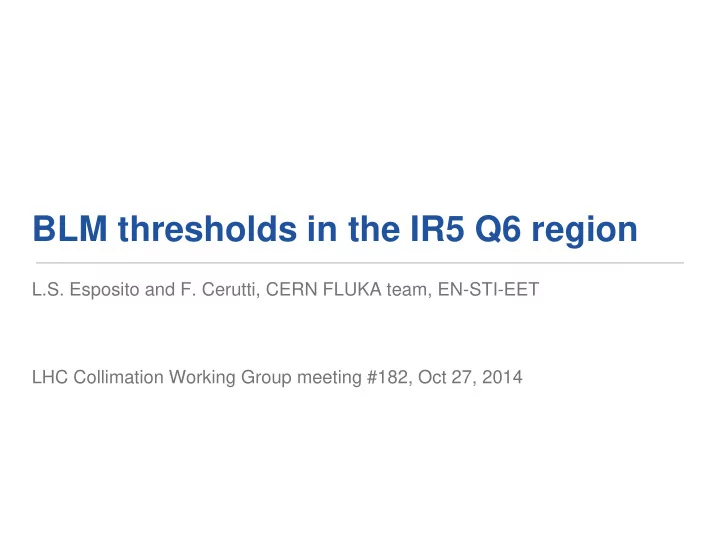

BLM thresholds in the IR5 Q6 region L.S. Esposito and F. Cerutti, CERN FLUKA team, EN-STI-EET LHC Collimation Working Group meeting #182, Oct 27, 2014
Summary from previous meetings - 1 with respect to 10 σ These considerations were first verified with respect to collision debris 2 Roman Pots operation and BLM signals F. Cerutti CWG # 182, Oct 27, 2014
Summary from previous meetings - 2 Later, the contribution from beam gas (and TCL6 impact on RR electronics) was discussed at Collimation WG #168 3 Roman Pots operation and BLM signals F. Cerutti CWG # 182, Oct 27, 2014
Roman Pot operation and vacuum levels - 1 From these data, it can be concluded that an important pressure gradient is present around RP stations Gas profile approximated by a rectangular spike of 8 × 10 16 H 2 /m 3 over 5 m centered at the RP220m location The effect of this simple gas spike is limited by construction to the Q6-Q7 region Roman Pots operation and BLM signals F. Cerutti CWG # 182, Oct 27, 2014
Roman Pot operation and vacuum levels - 2 what about vacuum levels? Roman Pots operation and BLM signals F. Cerutti CWG # 182, Oct 27, 2014
Roman Pot operation and vacuum levels - 3 7 10 -8 mbar VGPB.235.6R5.B.PR VGPB.2.6R5.B.PR VGI.77.6R5.B.PR VGPB.4.6R5.B.PR Roman Pots operation and BLM signals F. Cerutti CWG # 182, Oct 27, 2014
Let’s assume that pressure spikes are prevented - 1 impact on Q6 and Q7 from collision debris Roman Pots operation and BLM signals F. Cerutti CWG # 182, Oct 27, 2014
Let’s assume that pressure spikes are prevented - 2 BLM signals from collision debris Roman Pots operation and BLM signals F. Cerutti CWG # 182, Oct 27, 2014
Layout & FLUKA model refreshing - 1 Q7 RP RPT stations DQR Q6 Q5 9 Roman Pots operation and BLM signals F. Cerutti CWG # 182, Oct 27, 2014
Layout & FLUKA model refreshing - 2 RPT 10 Roman Pots operation and BLM signals F. Cerutti CWG # 182, Oct 27, 2014
Back to a pressure spike scenario - 1 impact on Q6 and Q7 from rectangular gas spike centered around FH220m normalisation is given by #interactions/s = I × ρ × σ p-H2 × L where: σ p-H2 = 2 × σ p-p ≃ 2 × 38.6 mb ρ = 8 × 10 16 molecules/m 3 I = 0.581/e A L = 5.0 m that gives ~ 1.1 × 10 7 interactions/s 11 Roman Pots operation and BLM signals F. Cerutti CWG # 182, Oct 27, 2014
Back to a pressure spike scenario - 2 BLM signals from rectangular gas spike centered around FH220m normalisation is given by #interactions/s = I × ρ × σ p-H2 × L where: σ p-H2 = 2 × σ p-p ≃ 2 × 38.6 mb ρ = 8 × 10 16 molecules/m 3 I = 0.581/e A L = 5.0 m that gives ~ 1.1 × 10 7 interactions/s 12 Roman Pots operation and BLM signals F. Cerutti CWG # 182, Oct 27, 2014
BLM signals: debris vs pressure spike 13 Roman Pots operation and BLM signals F. Cerutti CWG # 182, Oct 27, 2014
DS protection by TCL6 10 σ aperture of the TCL6 external jaw is necessary to protect Q9 This setting reduces the contribution of TCL6 to the impedance budget 14 Roman Pots operation and BLM signals F. Cerutti CWG # 182, Oct 27, 2014
Summary • Losses in 2012 and 2011 due to pressure spike induced by RP insertion • RP operation not harmful for Q6 and Q7, even with TCL6 open • BLM signals expected with 7 TeV beams at nominal lumi as well as in presence of a pressure spike have been evaluated • If TCL6 is closed at 10 sigma, significant increase of the Q6 BLM signal • TCL6 protects very effectively the DS, also in case of an asymmetric aperture 15 Roman Pots operation and BLM signals F. Cerutti CWG # 182, Oct 27, 2014
Spares
Contribution from timing RPs - 1 RPT disk 7.25 cm radius along z, 30 um thick RP rect 12.5 along z, 15 um thick 17 Roman Pots operation and BLM signals F. Cerutti CWG # 182, Oct 27, 2014
Contribution from timing RPs - 2 18 Roman Pots operation and BLM signals F. Cerutti CWG # 182, Oct 27, 2014
Comparison 4 TeV vs 7 TeV: debris TCL4 helps to reduce the BLM losses along the entire Matching Section 19 Roman Pots operation and BLM signals F. Cerutti CWG # 182, Oct 27, 2014
Comparison 4 TeV vs 7 TeV: pressure spike No strong dependence on energy 20 Roman Pots operation and BLM signals F. Cerutti CWG # 182, Oct 27, 2014
Recommend
More recommend